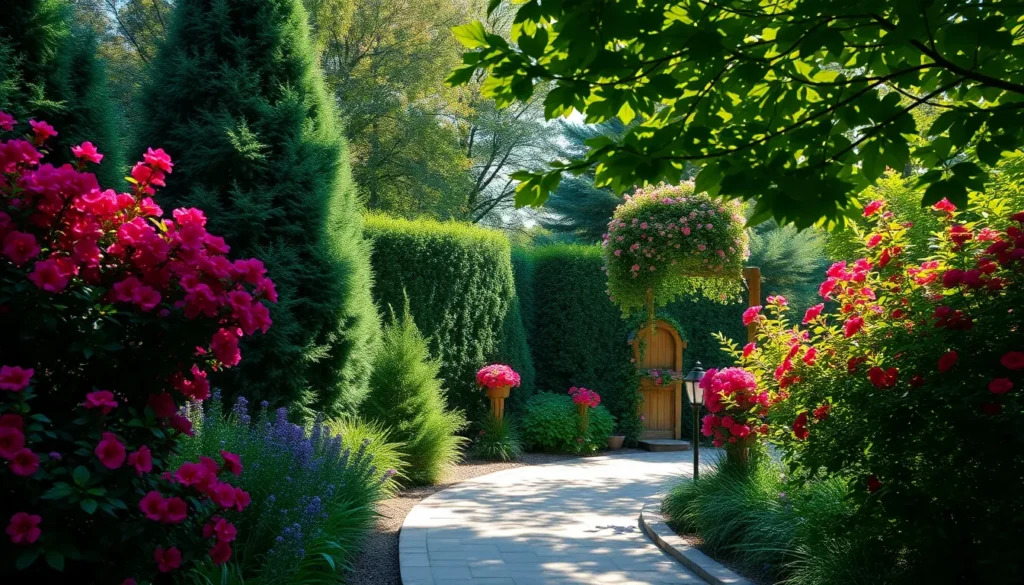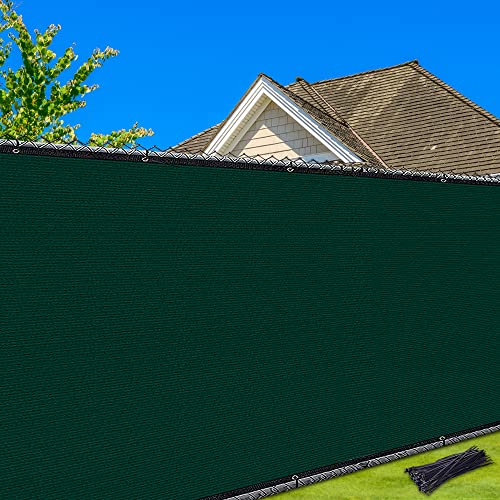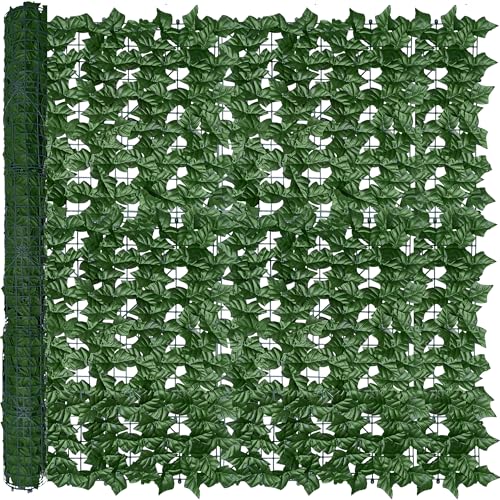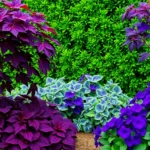We all crave that perfect outdoor sanctuary where we can unwind without prying eyes or nosy neighbors peering over the fence. Creating privacy in your garden isn’t just about blocking unwanted views – it’s about crafting an intimate space that feels like your own personal retreat.
Whether you’re dealing with overlooking windows busy sidewalks or simply want to create distinct zones within your outdoor space we’ve got practical answers that’ll transform your garden into a private oasis. From natural living screens to creative hardscaping ideas the possibilities are endless and more affordable than you might think.
The best part? Most privacy answers serve double duty by adding beauty functionality and even wildlife habitat to your garden. We’ll explore options that work for every budget space size and style preference so you can start enjoying your private outdoor haven sooner than later.
Create Natural Privacy Screens With Fast-Growing Trees
Fast-growing trees offer one of the most effective ways to establish natural privacy screens that mature quickly and provide lasting coverage. We can achieve substantial height and density within just a few growing seasons by selecting the right species for our climate and space.
Choose Evergreen Trees for Year-Round Coverage
Evergreen trees provide consistent privacy throughout all seasons, maintaining their foliage when we need screening most during winter months. Leyland cypress grows 3-4 feet annually and reaches 40-60 feet at maturity, creating dense barriers perfect for property lines. Green Giant arborvitae offers excellent wind resistance while growing 2-3 feet per year, eventually reaching 30-40 feet tall with a narrow 12-15 foot spread.
Eastern red cedar adapts to various soil conditions and grows 1-2 feet annually, providing both privacy and wildlife habitat. We recommend planting these evergreens 6-8 feet apart for faster coverage, though they’ll eventually need thinning as they mature. Norway spruce creates dramatic privacy screens with its classic Christmas tree shape, growing 2 feet per year in optimal conditions.
Plant Deciduous Trees for Seasonal Interest
Deciduous trees create ever-changing privacy screens that change with the seasons while offering rapid growth rates during their active periods. Hybrid poplar ranks among the fastest-growing options, adding 5-8 feet of height annually and reaching 40-50 feet at maturity. Weeping willow provides graceful screening near water features, growing 3-8 feet per year with cascading branches that create natural curtains.
Silver maple delivers quick results with 3-7 feet of annual growth, though we should plant it away from foundations due to its aggressive root system. Red oak offers beautiful fall color while growing 2-3 feet yearly, eventually creating substantial privacy barriers 50-75 feet tall. These deciduous options work best when planted in groupings of 3-5 trees to create layered screening effects.
Consider Fruit Trees for Dual-Purpose Privacy
Fruit trees combine privacy benefits with edible harvests, making them practical choices for garden privacy screens. Apple trees on semi-dwarf rootstock grow 12-15 feet tall while producing fruit within 3-4 years of planting. Pear trees create dense foliage screens during growing season, with varieties like Bartlett reaching 15-20 feet and offering spring blossoms plus fall fruit.
Cherry trees provide stunning spring flowers followed by summer fruit, with sweet cherry varieties growing 20-25 feet tall for effective screening. We can plant multiple fruit tree varieties in staggered rows to extend both the harvest season and privacy coverage. Plum trees work well in smaller spaces, reaching 8-12 feet while producing abundant fruit and creating effective low-level privacy barriers perfect for patio areas.
Install Living Fence Solutions With Hedges and Shrubs
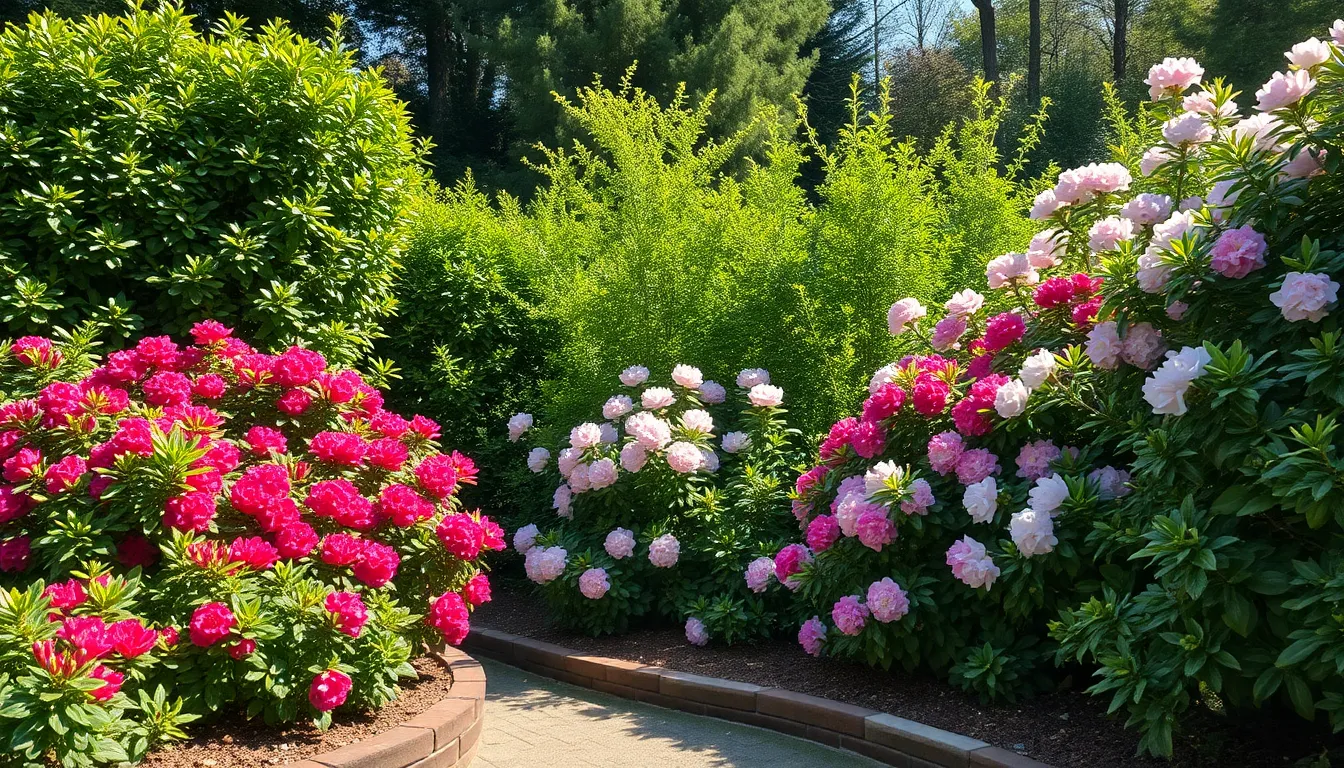
Shrubs and hedges create natural privacy barriers that blend seamlessly with your garden’s industry. These living fences offer a sustainable alternative to traditional fencing while providing habitat for wildlife.
Select Dense Shrubs for Maximum Privacy
Laurel shrubs deliver exceptional privacy coverage with their thick, glossy evergreen foliage that maintains density throughout the year. We recommend planting laurel varieties for areas where you need complete visual screening from neighbors or street traffic.
Holly bushes provide year-round privacy while adding decorative berries and spiny leaves that deter unwanted visitors. These hardy shrubs thrive in various soil conditions and create impenetrable barriers when planted closely together.
Rhododendron varieties offer stunning seasonal blooms alongside their privacy benefits, making them perfect for gardeners who want beauty and function. Their broad leaves create excellent screening while providing spectacular spring color displays.
Privet hedges grow rapidly and respond well to pruning, allowing you to shape them into formal privacy screens. These versatile shrubs adapt to different growing conditions and maintain their screening properties even in challenging environments.
Photinia shrubs feature attractive red new growth that adds visual interest to your privacy plantings. We find these plants particularly effective for creating medium-height screens that don’t overwhelm smaller garden spaces.
Honeysuckle and forsythia provide seasonal privacy while attracting beneficial pollinators to your garden. Both shrubs offer rapid growth and require minimal maintenance once established.
Design Multi-Layered Hedge Borders
Layered vegetation creates more effective privacy by combining plants of different heights and textures. We suggest placing taller shrubs in the back row with medium-height plants in front to create depth and visual interest.
Soil berms raise your planting level and enhance the screening effect of your hedge borders. Building these raised areas allows you to create privacy barriers even when space is limited.
Mixed plant heights prevent the monotonous appearance of single-species hedges while providing varied habitat for wildlife. Consider combining evergreen shrubs with deciduous varieties for year-round interest and seasonal change.
Staggered planting patterns create natural-looking privacy screens that mimic woodland edges. This approach provides better coverage than straight-line plantings while reducing the formal appearance of traditional hedges.
Maintain Proper Spacing for Healthy Growth
Adequate spacing ensures each plant receives sufficient light, air circulation, and nutrients for optimal growth. Overcrowding leads to weak plants that become susceptible to disease and pest problems.
Growth habit considerations determine the appropriate distance between shrubs in your privacy hedge. Research mature sizes of your chosen plants to avoid future overcrowding and maintain the integrity of your living fence.
Maintenance access between plants allows you to prune, fertilize, and monitor plant health effectively. Leave enough space to walk between rows of larger shrubs for ongoing care and maintenance tasks.
Root zone protection prevents competition between neighboring plants and ensures healthy establishment. Proper spacing allows root systems to develop fully without interference from adjacent plantings.
Build Vertical Privacy Features With Trellises and Arbors
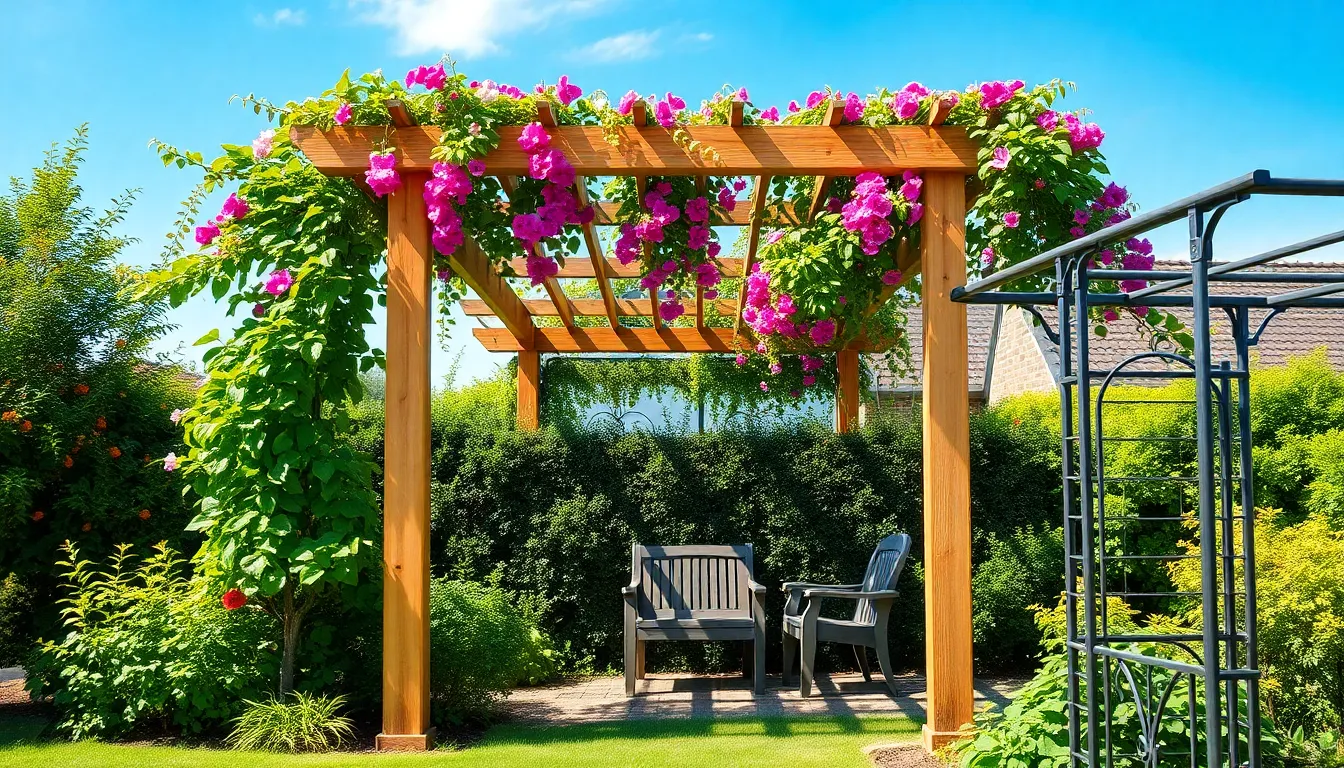
Vertical privacy answers offer immediate height and visual interest while maximizing your garden’s footprint. These structures create intimate outdoor rooms that blend functionality with natural beauty.
Construct Wooden Trellis Systems
Wooden trellis frameworks provide the perfect foundation for climbing plants while adding instant architectural appeal to your garden. We recommend positioning these structures near seating areas where you’ll most benefit from enhanced privacy and visual screening. Cedar and pressure-treated pine offer excellent durability for outdoor trellis construction.
Lattice patterns work exceptionally well for supporting lightweight climbing plants while allowing air circulation. Standard 6-foot tall panels create adequate privacy for most residential settings. Assembly becomes straightforward when you use pre-cut lattice panels and sturdy corner posts.
Installation requires digging post holes approximately 2 feet deep for stability in various weather conditions. Concrete footings ensure your trellis system remains secure throughout seasons of plant growth and wind exposure.
Install Metal Arbor Structures
Metal arbors deliver superior strength for supporting heavy climbing plants while creating stunning garden focal points. These structures serve dual purposes as natural gates or entrance features that welcome guests into private garden spaces. Powder-coated steel and aluminum options resist rust and weathering for years of low-maintenance beauty.
Arched designs complement traditional garden styles while contemporary geometric shapes suit modern industry designs. We suggest choosing arbor widths between 4 to 8 feet to accommodate comfortable walkways underneath mature plant growth. Standard heights of 7 to 8 feet provide adequate clearance for most climbing plants.
Professional installation ensures proper foundation work that prevents settling or tilting over time. Many homeowners successfully install smaller arbor kits using basic tools and weekend project time.
Add Climbing Plants for Enhanced Coverage
Strategic plant selection transforms basic structures into lush privacy screens that evolve throughout growing seasons. Perennial Sweet Pea delivers fragrant blooms while creating dense coverage that returns year after year. Honeysuckle varieties provide rapid growth and attractive flowers that support local wildlife populations.
Clematis Montana offers spectacular spring flowering displays with vigorous climbing habits perfect for covering large trellis areas. These plants typically reach mature heights of 15 to 20 feet when properly supported. Planting multiple varieties creates extended blooming periods and diverse textures.
Spring installation allows plants to establish root systems before summer heat stress. We recommend spacing climbing plants 3 to 4 feet apart along trellis bases for optimal coverage without overcrowding. Regular pruning maintains healthy growth while preventing structures from becoming overwhelmed by plant weight.
Design Privacy Walls Using Natural Materials
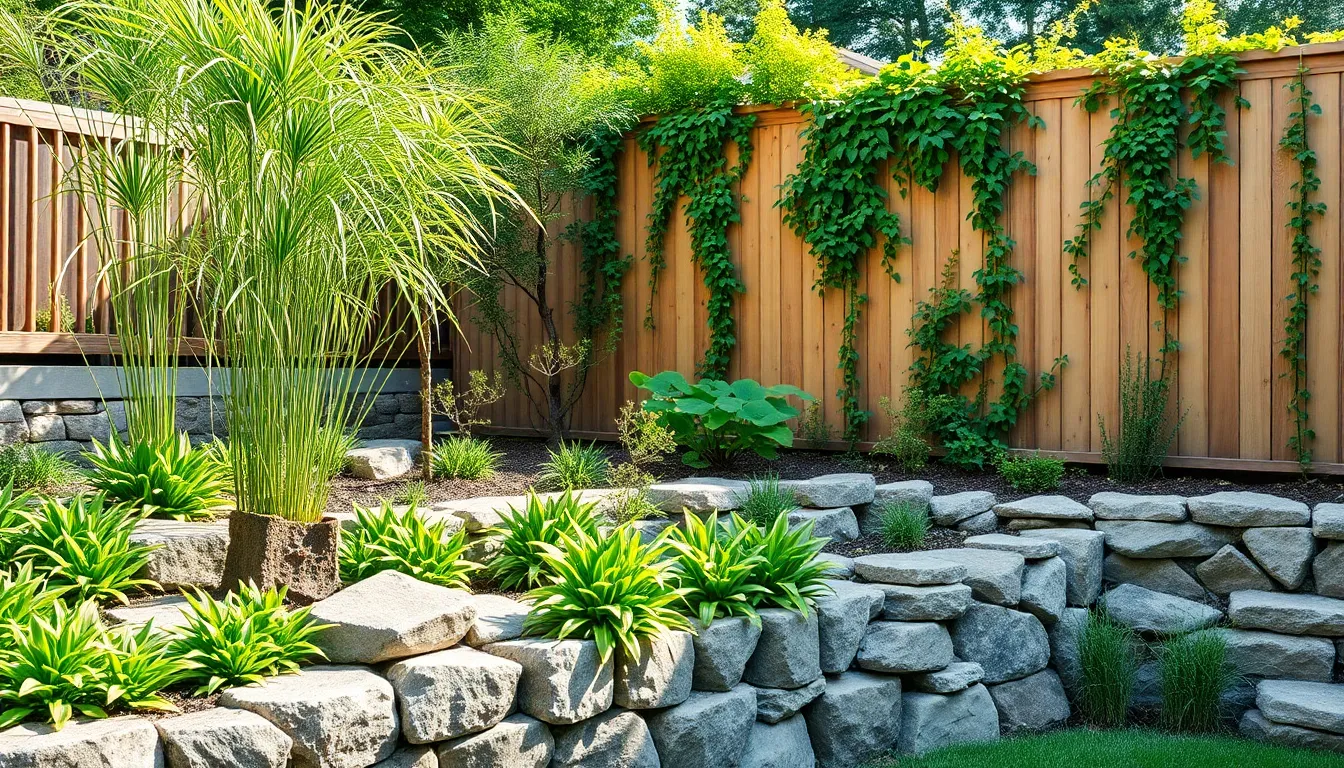
Natural materials transform ordinary garden boundaries into stunning privacy features that blend seamlessly with your industry. These organic answers create intimate spaces while maintaining the garden’s natural aesthetic appeal.
Build Stone Retaining Walls
Stone retaining walls serve as both functional barriers and aesthetic elements that define our garden boundaries effectively. These natural structures provide excellent privacy screening while adding timeless elegance to any outdoor space. We can use fieldstone, limestone, or granite to create walls that complement our existing industry design perfectly.
Dry-stacked stone walls offer the most natural appearance and allow for proper drainage throughout the structure. Mortared stone walls provide greater stability and height options for areas requiring maximum privacy coverage. We’ll want to incorporate planting pockets between stones to soften the appearance and encourage natural integration with surrounding vegetation.
Create Bamboo Panel Screens
Bamboo panels offer an instant privacy solution that integrates seamlessly into garden landscapes while aging beautifully over time. These versatile screens can be hung from trellises, attached to existing fences, or used as freestanding barriers depending on our exact needs. We can install bamboo panels quickly without extensive construction work or specialized tools.
Natural bamboo weathers to an attractive silver-gray color that complements most garden styles and plant combinations. Rolled bamboo fencing provides flexibility for curved installations and irregular spaces that standard panels cannot accommodate. We should secure bamboo screens with galvanized hardware to ensure longevity and prevent premature deterioration from weather exposure.
Construct Wooden Privacy Fences
Wooden fences represent a classic choice for garden privacy that blends well with most surroundings and architectural styles. These durable structures provide reliable screening while offering endless customization possibilities through stain colors, board patterns, and height variations. We can enhance wooden fences further with climbing plants or trailing vines to create natural barriers that soften hard edges.
Cedar and pressure-treated pine deliver the best longevity for outdoor fence construction in most climate conditions. Board-on-board designs maximize privacy coverage while allowing air circulation that prevents moisture buildup and plant disease issues. We’ll achieve optimal results by combining wooden fencing with fast-growing plants and vines that transform ordinary barriers into living privacy screens.
Incorporate Water Features for Sound Privacy
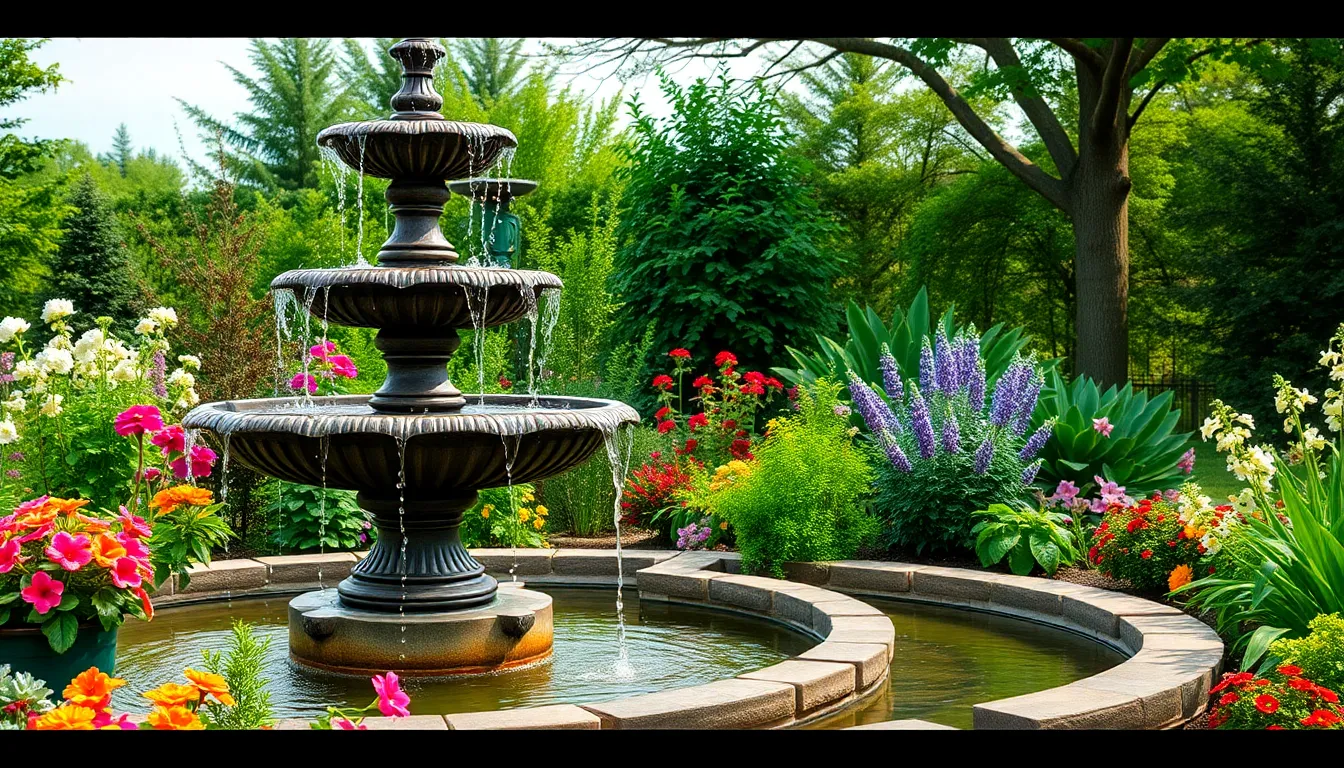
Water features transform our gardens into peaceful retreats while providing an elegant solution for blocking unwanted noise. The gentle sounds of flowing water create natural white noise that masks conversations from neighboring properties and street traffic.
Install Fountain Systems
Fountain systems offer immediate sound privacy benefits while adding visual appeal to our outdoor spaces. We can choose from tiered fountains that create cascading water sounds or simple bubbling fountains that provide subtle background noise. Wall mounted fountains work perfectly in smaller gardens where space is limited, and they can be integrated into existing privacy walls or fences.
Solar powered fountain systems eliminate the need for electrical connections and reduce operating costs. These eco friendly options run continuously during daylight hours when we’re most likely to use our outdoor spaces. Recirculating pump systems ensure water conservation while maintaining consistent sound levels throughout the day.
Create Natural Pond Barriers
Natural pond barriers combine privacy screening with the soothing sounds of water movement. We can position ponds strategically along property lines to block sight lines while creating habitat for wildlife. Raised pond edges using natural stone or timber provide additional height for enhanced privacy coverage.
Waterfall features integrated into pond designs amplify sound privacy benefits significantly. The continuous flow of water over rocks or constructed spillways masks neighboring conversations effectively. Aquatic plants like cattails and water lilies add natural screening around pond perimeters while supporting the network.
Add Flowing Water Elements
Flowing water elements create ever-changing soundscapes that enhance our garden’s privacy potential. Stream features that meander through planted areas provide both visual interest and acoustic barriers. We can construct these using flexible pond liner and natural stone to create realistic water courses.
Cascading water walls built into retaining structures serve dual purposes as privacy screens and sound barriers. These vertical water features maximize impact in compact spaces while creating dramatic focal points. Adjustable flow controls allow us to customize sound levels based on seasonal needs and surrounding noise conditions.
Establish Ground-Level Privacy With Strategic Landscaping
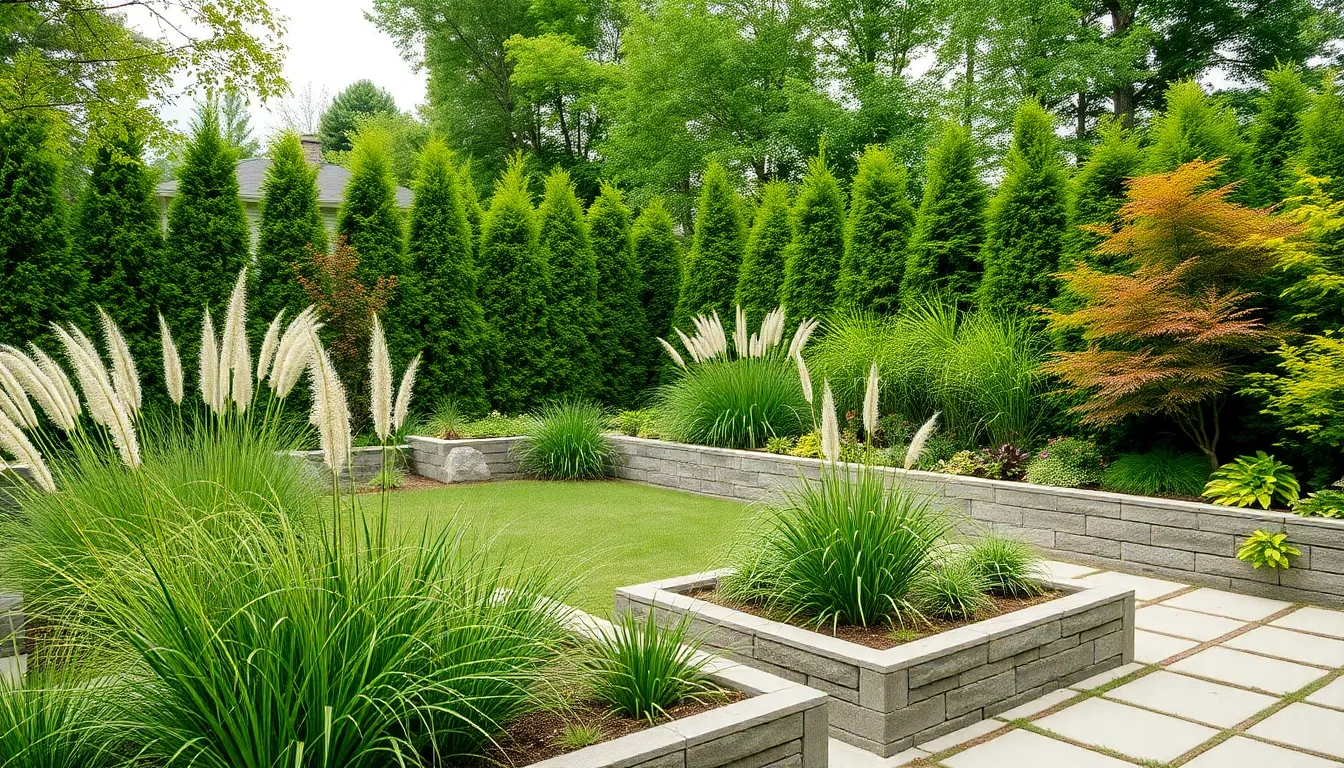
Ground-level landscaping transforms your garden into a private retreat while maintaining natural beauty and visual appeal. Strategic placement of plants creates effective barriers that blend seamlessly with your existing industry design.
Plant Ornamental Grass Borders
Ornamental grass borders offer a lighter and airier alternative to traditional dense hedging while still providing effective privacy screening. Panicum and Miscanthus varieties create natural screens that allow filtered light to pass through, maintaining an open feel in your garden space. These grasses reach heights of 4-6 feet when mature, creating substantial visual barriers without overwhelming smaller garden areas.
Perennial grasses require minimal maintenance once established and provide year-round interest with their changing seasonal colors and textures. We recommend planting these grasses in staggered rows to maximize coverage while creating natural movement and depth. Wind movement through the grass blades adds gentle sound elements that further enhance your garden’s privacy atmosphere.
Design Raised Garden Bed Barriers
Raised garden beds serve dual purposes as both functional growing spaces and effective privacy barriers throughout your industry. Elevated planting areas naturally block ground-level sight lines while creating opportunities for layered plant installations. We suggest constructing raised beds 18-24 inches high to establish immediate visual separation between spaces.
Taller plants positioned at the edges of raised beds enhance the privacy screening effect without requiring extensive root systems. Combining vegetables, herbs, and ornamental plants in these elevated barriers creates productive privacy answers that maximize your garden’s functionality. Strategic placement of multiple raised beds creates private garden rooms and intimate outdoor spaces.
Create Tiered Planting Schemes
Tiered planting schemes combine multiple plant heights to create comprehensive privacy coverage while maintaining visual interest and natural aesthetics. Redbuds and Japanese maples serve as excellent mid-story trees that provide overhead screening while allowing clear views at trunk level. These smaller trees typically reach 15-25 feet at maturity, creating substantial privacy without overwhelming residential landscapes.
Layered perennials planted beneath these trees fill in lower sight lines and create continuous screening from ground level upward. Columnar trees planted behind the mid-story layer filter upper-level views while maintaining the natural flow of your industry design. We recommend spacing plants according to their mature widths to prevent overcrowding and ensure healthy growth patterns throughout your tiered privacy installation.
Add Temporary Privacy Solutions for Flexibility
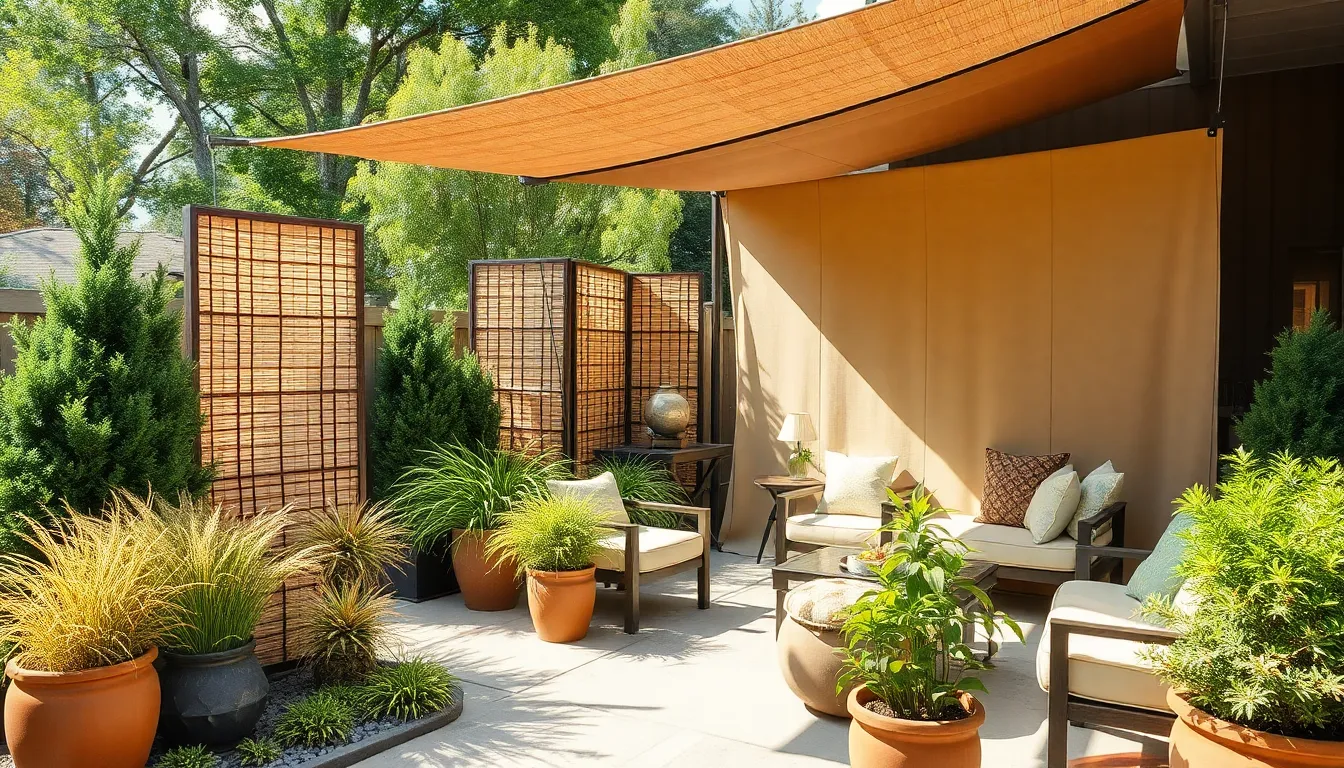
Temporary privacy answers offer the perfect balance between immediate screening needs and future design flexibility. These moveable options let us adapt our garden privacy as seasons change or our outdoor living needs evolve.
Use Portable Screen Dividers
Portable screen dividers give us instant privacy control wherever we need it most in our gardens. These lightweight barriers can be easily repositioned to block exact sight lines from neighboring windows or create intimate conversation areas around seating spaces.
Material options for portable screens include bamboo panels, fabric screens, and decorative metal designs that complement our existing garden aesthetic. Weather resistant screens made from synthetic materials withstand seasonal changes while maintaining their screening effectiveness throughout the year.
Strategic placement allows us to experiment with different privacy configurations before committing to permanent installations. We can move these dividers to shelter morning coffee spots, afternoon reading nooks, or evening entertaining areas as our outdoor activities shift with the seasons.
Install Retractable Shade Systems
Retractable shade systems provide dual functionality by offering both privacy screening and sun protection on demand. These adjustable systems extend when we need coverage and retract when we want open views or more natural light in our garden spaces.
Modern retractable awnings come in various sizes to fit different garden areas, from compact patio covers to large pergola spanning systems. Manual crank operations and motorized options give us control over deployment speed and convenience based on our preferences and budget.
Fabric choices range from solid colors that provide complete privacy to semi transparent materials that filter views while maintaining some visibility. Strategic installation along property lines or over seating areas creates flexible privacy zones that adapt to different times of day and weather conditions.
Deploy Seasonal Plant Containers
Seasonal plant containers create moveable green screens that we can relocate throughout our gardens as privacy needs change. Large planters filled with tall growing plants like bamboo, arborvitae, or ornamental grasses provide immediate screening while allowing us to experiment with placement before permanent planting.
Container gardening for privacy works especially well in rental properties or spaces where permanent landscaping isn’t possible. We can select fast growing varieties like bamboo clumping species or evergreen shrubs that maintain their screening properties year round in appropriate sized planters.
Wheeled planter bases make repositioning large containers manageable, letting us create seasonal privacy arrangements for outdoor parties or shift screening to follow changing sun patterns. These portable plant walls can be arranged in curved lines, straight borders, or clustered groupings to create custom privacy configurations that suit our immediate needs.
Combine Multiple Privacy Elements for Maximum Effect
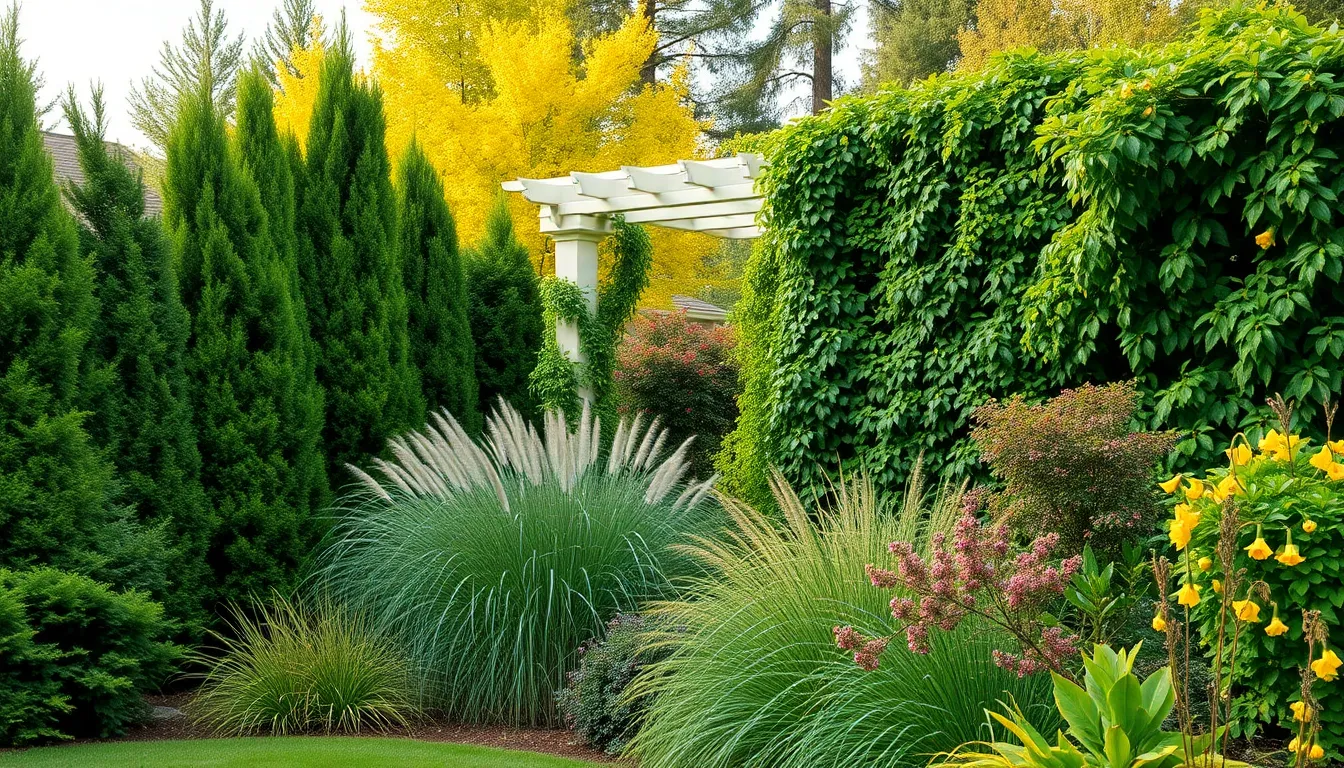
Combining trees, hedges, pergolas, berms, and living walls together creates the most effective privacy screening while establishing a true sense of refuge in your garden.
Layer Different Height Plants
Strategically placing tall trees and shrubs with lower growing plants around them enhances your garden’s sense of privacy through natural layering. We recommend starting with evergreen trees like Green Giant arborvitae as your backdrop, then adding mid-height shrubs such as laurel or rhododendron in front. Ornamental grasses and perennial borders complete the layered effect at ground level.
This approach creates depth while blocking sightlines from multiple angles. Dense plantings at varying heights also provide habitat for beneficial wildlife and improve your garden’s microclimate. Consider spacing your layers 3-4 feet apart to allow for mature growth and maintenance access.
Mix Permanent and Temporary Answers
Using permanent structures like walls or pergolas alongside temporary answers such as ornamental grasses or seasonal plantings offers flexibility as your privacy needs change. Stone retaining walls provide year-round screening, while portable bamboo panels let you adjust coverage based on seasonal activities or garden renovations.
Seasonal container plantings work exceptionally well for testing privacy configurations before committing to permanent installations. We’ve found that combining a fixed trellis system with annual climbing vines gives you immediate coverage while perennial climbers establish themselves. This strategy also spreads your investment over time while maintaining effective privacy.
Balance Privacy With Garden Aesthetics
Selecting plants and structures that provide privacy while improving your garden’s beauty requires thoughtful planning and design integration. Colorful blooms like forsythia or honeysuckle add visual interest to privacy hedges, while textured foliage from plants like photinia creates year-round appeal.
Smart pergolas and living walls maximize space efficiency while serving as architectural focal points in modern garden designs. These innovative answers improve air quality and can integrate with smart home systems for enhanced functionality. Consider how each privacy element contributes to your garden’s overall style, whether you prefer formal hedged borders or naturalistic mixed plantings.
Conclusion
We’ve explored many ways to transform your garden into a private sanctuary that perfectly balances functionality with natural beauty. From fast-growing trees and living hedges to innovative water features and flexible screening answers each approach offers unique benefits that can be customized to your exact needs and budget.
The key to successful garden privacy lies in thoughtful layering and strategic planning. We recommend combining permanent elements like stone walls or evergreen trees with adaptable features such as portable screens or seasonal containers. This approach gives you the flexibility to adjust your privacy levels as your outdoor living needs evolve.
Remember that effective privacy doesn’t mean sacrificing style. The best garden privacy answers enhance your industry’s aesthetic appeal while creating the intimate retreat you deserve. Whether you choose natural living screens or hardscaping elements your investment will provide years of peaceful outdoor enjoyment.
Frequently Asked Questions
What are the fastest-growing trees for privacy screening?
Fast-growing evergreen options include Leyland cypress and Green Giant arborvitae, which provide year-round coverage. For deciduous varieties, hybrid poplar and weeping willow offer rapid growth with seasonal interest. Fruit trees like apple or pear also work well, providing both privacy and edible harvests while growing relatively quickly.
How do I create an effective living fence with shrubs?
Plant dense shrubs like laurel, holly, or privet in staggered patterns for maximum coverage. Use soil berms to add height and create multi-layered borders. Space plants properly to ensure healthy growth and maintenance access. Consider combining different shrub varieties for year-round interest and enhanced privacy screening.
What vertical privacy features work best for small gardens?
Trellises and arbors maximize vertical space while providing immediate height. Use durable materials like cedar or pressure-treated pine, and add climbing plants such as Clematis Montana or honeysuckle for enhanced coverage. Metal arbor structures offer strength and can serve as focal points or entrance features.
How can water features enhance garden privacy?
Water features mask unwanted noise from neighbors and street traffic through sound privacy. Fountain systems provide immediate acoustic benefits, while natural ponds create dual-purpose barriers with soothing sounds. Waterfalls and flowing streams create dynamic soundscapes that enhance both visual and acoustic privacy elements.
What are the best temporary privacy solutions?
Portable screen dividers made from bamboo, fabric, or decorative metal can be easily repositioned as needed. Retractable shade systems offer dual-function privacy and sun protection. Seasonal plant containers create moveable green screens, allowing you to experiment with different placement and privacy configurations throughout the year.
How do I combine multiple privacy elements effectively?
Layer different height plants starting with tall evergreen trees as backdrop, followed by mid-height shrubs and ornamental grasses. Balance permanent solutions like stone walls with temporary options like portable panels for flexibility. Ensure privacy elements enhance aesthetics by incorporating colorful blooms and well-designed structures.

